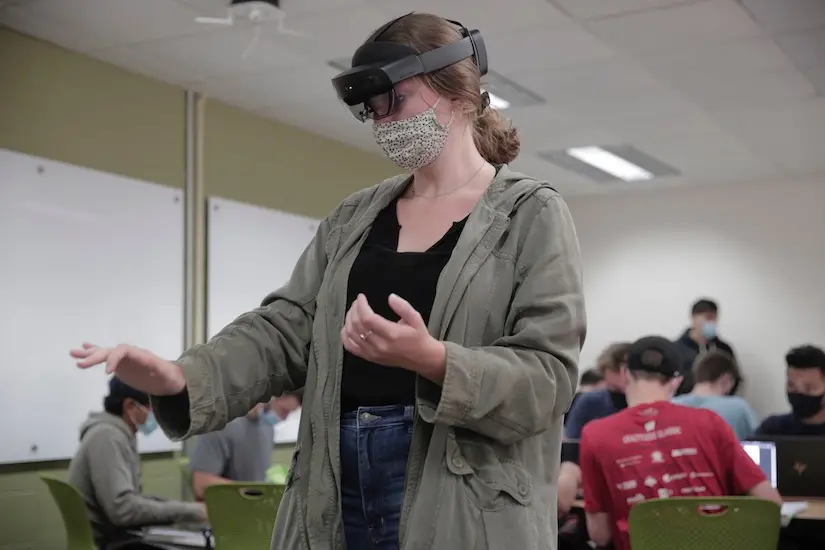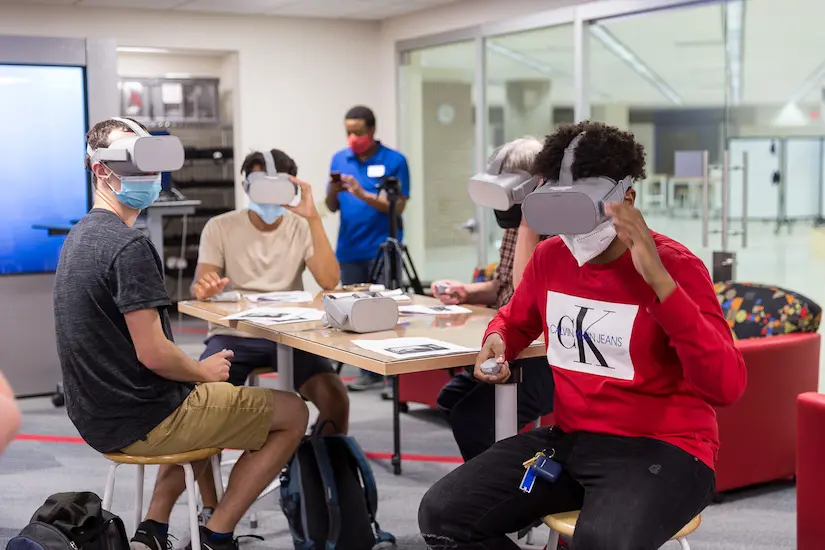Hannah Blum is blending the virtual with what’s real for students in her Steel Structures 1 class.
Blum, an assistant professor of civil and environmental engineering and the Alain H. Peyrot Fellow of Structural Engineering, has been a trailblazer within the College of Engineering when it comes to using virtual reality for teaching her students. Now, she’s using a blend of augmented and virtual reality learning tools to help students visualize—in striking detail—the sorts of work they’ll do as structural engineers.
 Civil engineering student Meg Hinaus uses the Microsoft HoloLens augmented reality device to examine fractures in a steel structure. Photo by Alex Holloway.
Civil engineering student Meg Hinaus uses the Microsoft HoloLens augmented reality device to examine fractures in a steel structure. Photo by Alex Holloway.
For one such learning tool, Blum is using Microsoft HoloLens. The HoloLens fits like a pair of futuristic glasses and projects a computer-rendered image over the wearer’s field of vision. In one class period, Blum’s students used the technology to view a bolted steel connection. Using the HoloLens controller, they could interact with the steel as if it were in front of them, and pull it apart to see what an actual fracture would look like. The accompanying software application asked students to identify which pieces of the steel structure would break off together and provided immediate feedback on their answers.
This type of education has come a long way from looking at flat pictures in a textbook. It’s one of the first—if not the first—such uses for the HoloLens as a teaching tool at UW-Madison.
“If you compare this to what’s in textbooks, students are getting much better visualization through the HoloLens,” Blum says. “It’s there in 3D; you can walk around and view it from different angles. You can virtually hold it, twist it, pull it apart and put it back together. This is so much better compared to looking at a book.”
In another class session, Blum took students to the new Kohler Innovation Visualization Studio in the College of Engineering’s Makerspace. There, her students used Oculus virtual reality headsets to take a guided tour, narrated by the project’s lead engineer, of the 51st floor of a recently-completed skyscraper in Chicago. The tour was recorded while the building was under construction.
The narrator explained engineering concepts as students moved throughout the construction site, and there were various popups along the way for students to interact with for more information.
“This was the type of tour they’d get if they were on a class field trip,” Blum says. “You stop at a point of interest and a guide would talk, point things out, and then you’d move to the next stop. This is a great tool for us because field trips like this aren’t often an option—it’s not always safe enough onsite to do this, or the timing might not line up correctly for a class to visit.”
The mixed reality sessions have been a hit with Blum’s students. Abby Grant says the virtual tour reminded her of some of the construction sites she’s worked on for the past two summers. She says some of the subjects that came up during the tour were ones they hadn’t yet learned in class, but the experience served as a great introduction. Grant also liked how the tour implemented the building’s design plans.
 Students in Hannah Blum’s Steel Structures 1 class use Oculus virtual reality headsets in the Kohler Innovation Visualization Studio to tour a skyscraper construction site in Chicago. Photo by Joel Hallberg.
Students in Hannah Blum’s Steel Structures 1 class use Oculus virtual reality headsets in the Kohler Innovation Visualization Studio to tour a skyscraper construction site in Chicago. Photo by Joel Hallberg.
“Someone I worked with at a co-op once told me that one of the best ways to learn on a construction site is to look at how the drawings compare to what’s actually going on in the field,” Grant says. “You look at the drawing and try to point out exactly what parts on the site go with the drawings. They used plans in the tour, and that seemed to be what they were trying to do for us.”
Student Alex Muhl says the virtual tour was enlightening and engaging and enabled him to see structures within the building from multiple angles. For example, he could look down at the steel and concrete composite floor while the narrator talked about it, and look up to the floor above to see the same structure’s underside.
“The narration was really helpful, and had visual aids and diagrams or floor plans that were very good,” Muhl says. “It was very well organized, and I definitely think it worked a lot better than just seeing static pictures. You could look around and see things from different angles. I enjoyed it so much more than just looking at pictures in a regular classroom setting and being told what’s what in the picture.”
To create this unique experience for her students, Blum and her PhD student Ed Sippel worked with partners on campus and in industry. Blum and Sippel designed the tools with aid from the UW-Madison Division of Information Technology’s web and mobile solutions team as well as the Wisconsin Institute for Discovery, and a computer science undergraduate student programmed much of the HoloLens tool. The American Institute of Steel Construction was a major partner for the virtual construction tour and provided a model for another virtual reality tool in which students match floor plans to a virtual three-story building. Blum has received grants from the College of Engineering and from the UW-Madison provost’s office to support her work so far.
It sounds like a big undertaking, but Blum says it’s worth the effort and hopes to see wider uptake of mixed reality learning within the college and beyond. She says it’s important not only as a fun, hands-on way for students to learn but because it gives valuable preparation for when they move into their careers.
“Companies are starting to use this technology,” she says. “They might have a virtual reality walkthrough for a client to show what a building looks like. Some construction software companies are using mixed reality to overlay models onto construction sites. We want students to be familiar with this technology so that they’re prepared when they go out into the workforce.”